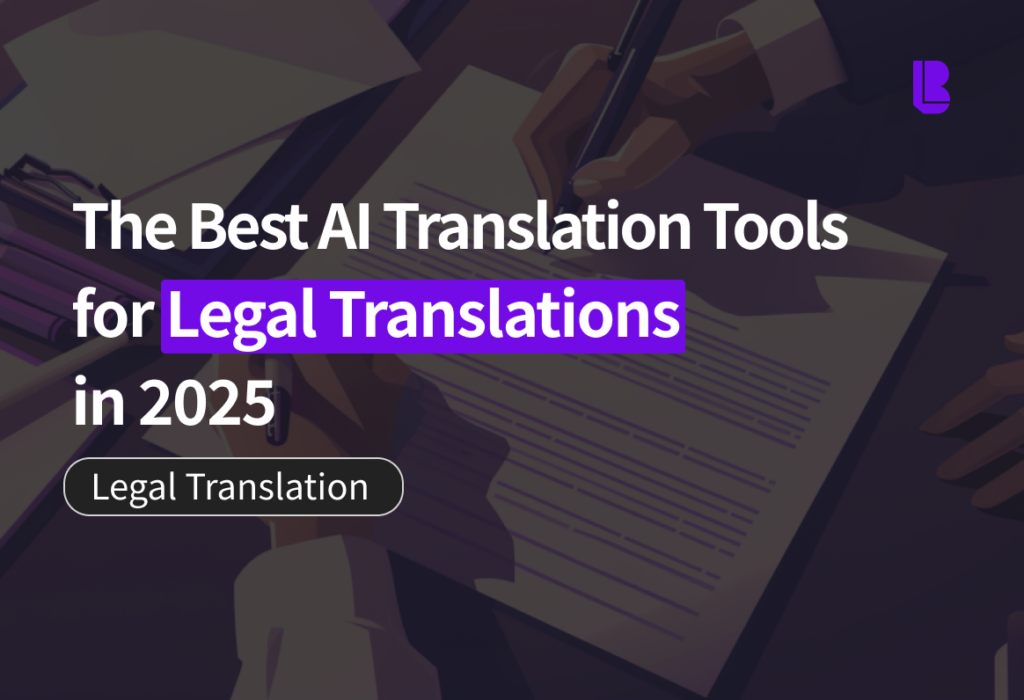AI translation is all the rage right now for tackling huge volumes and bringing down costs. Many businesses struggling to get translation done effectively are evaluating it for use, and rightly so: the tools all offer high accuracy, lower costs, and lightning-fast speed. While today’s best tools do offer impressive speed and consistency, legal teams need to think about it more broadly: strong AI translation for legal content ALSO requires domain-specific accuracy, data security, and expert oversight.
So, which is the best AI translation tool for your legal documents? We’re here to help you sort fact from fiction and make good choices for your legal department. But first, let’s talk about the advantages and disadvantages of AI translation in the legal domain.
✍️ 6 Advantages and 4 Disadvantages of AI Translation in the Legal Context
AI translators bring 6 important benefits to the table.
- Speed is a major advantage, enabling large volumes of text to be translated quickly.
- Scalability also becomes much easier, allowing organizations to handle growing volumes of documents without added strain.
- Consistency is another strength, with AI helping maintain uniform terminology across all documents, which is critical in the legal field where precision and coherence are paramount.
- Cost efficiency improves as overall translation project expenses are significantly reduced, freeing up resources for other core business activities.
- Around-the-clock availability ensures that teams can access translation services whenever they need them.
- Data security features are increasingly being built into AI translation tools, helping protect sensitive legal information and ensuring compliance with confidentiality requirements.
On the other hand, here are the top 4 limitations:
- Generic tools struggle with nuance, context, and jurisdiction-specific phrasing.
- Errors in machine-generated legal translations can result in significant legal risk.
- Machines often misinterpret cultural tone or legal norms, translating the words precisely but getting the context and nuance wrong.
- Security and confidentiality can be a problem with public tools: lack secure processing, use your data to train their engine, or lack proper deletion protocols.
Let’s move on to the top AI translation tools being used in legal and business settings in 2025, along with important considerations when choosing the right solution.
✅ Key AI Translators for Legal Translations
1. Google Translate
Google Translate runs on Neural Machine Translation (NMT), a deep learning system that uses neural networks to process and translate text.
Google has also built a specialized Large Language Model (LLM) called the Translation LLM, which has been trained on millions of examples to handle longer and more complex texts better.
Their translation tools include Adaptive Translation, an API method that fine-tunes results by working alongside the Translation LLM. Through Google’s AI Studio, users can pick from different models for their translation needs, including the Translation LLM, Gemini, and Google’s traditional translation engines.
While Google Translate offers quick results in dozens of languages, it has important drawbacks when it comes to legal translations. The translations can often be too general, missing the precision and deep understanding that legal documents require.
There’s also a serious security risk: any text entered into Google Translate can be stored, analyzed, and even accessed by third parties. This makes it unsafe for translating confidential or sensitive legal materials.
Because of these risks — and the lack of specialized legal accuracy — Google Translate should never be used for important legal documents.
👍 Advantages:
- Supports a wide range of languages
- Fast and easy to access
- Continually updated with new AI improvements
⚠️ Disadvantages:
- Lacks legal domain expertise and precision
- Major data security risks (data can be stored or analyzed)
- Output can be too general or inaccurate for professional use
2. DeepL
DeepL is a general-purpose machine translation engine, known for its contextual accuracy and fluency across multiple languages. It performs well for mid-level business translation needs, but it’s not trained specifically on legal corpora and may miss domain-specific subtleties.
As we’ve explained, domain-specific training is critical for accuracy in legal translations. So, if you choose DeepL, a third-party professional review is strongly recommended to mitigate risk.
👍 Advantages:
- Produces high-quality, natural-sounding translations
- Strong handling of European languages
- Offers customizable glossaries for more consistent terminology
⚠️Disadvantages:
- Limited language range compared to Google Translate
- Still lacks specialized legal translation training
- Paid features are needed for full data security and professional use
3. Publicly available LLMs like ChatGPT and Llama
Large Language Models (LLMs) like ChatGPT and Llama are powerful AI tools trained on vast amounts of publicly available data. They can generate translations, summaries, and other types of text quickly and efficiently.
However, because they are general-purpose models, they aren’t specifically trained for legal language or sensitive document handling. This can lead to translations that miss important legal nuances or introduce inaccuracies.
Another major concern is data security: information entered into public LLMs may be stored or used to further train the models, making them unsuitable for confidential legal work. For sensitive or high-stakes legal translations, specialized and secure solutions are a must.
👍 Advantages:
- Versatile: can generate, summarize, and translate a wide range of content
- Continuously improving with updates and new capabilities
- Easy to access and use, even for non-technical users
⚠️ Disadvantages:
- Not trained specifically for legal language or workflows
- Data entered may be stored, analyzed, or reused (serious confidentiality risk)
- Can produce outputs that lack the precision and consistency needed for legal documents
3. Papago
Papago is a translation tool developed by Naver, primarily utilizing Neural Machine Translation (NMT) technology. It excels in Korean-English translations, particularly for informal or general content.
However, Papago is not specifically trained on legal terminology or structures, which limits its effectiveness in legal contexts. Its translations may lack the precision and contextual understanding required for legal documents.
👍 Advantages:
- Strong performance in Korean-English translation
- Good for informal, everyday content
- User-friendly interface and quick results
⚠️ Disadvantages:
- Not designed for legal or technical translations
- Lacks deep contextual and specialized understanding
- Requires expert post-editing for any legal or professional use
4. translated.net
Translated.net is a hybrid translation platform that leverages both AI and a global network of professional linguists. It’s widely used in commercial settings and offers domain-trained models upon request. For legal documents, quality still depends on requesting specialized review services.
👍Advantages:
- Offers a blend of AI translation with human post-editing
- Supports a broad range of languages and industries
- Platform includes project management tools for large translation jobs
⚠️ Disadvantages:
- Quality varies depending on project setup (fully machine vs human reviewed)
- Machine-only output is not reliable for legal contexts
- Costs can rise significantly when human review is added
5. Phrase
Phrase is a translation management system that integrates MT engines and CAT tools into a centralized platform. While it offers productivity gains, it’s more of an infrastructure tool than a dedicated legal AI translator. It can be a strong part of a larger workflow, but not a standalone solution for legal accuracy.
👍 Advantages:
- Strong platform for managing localization projects
- Supports integration with various translation engines
- Good collaboration tools for teams and translators
⚠️ Disadvantages:
- Focused more on software localization than legal translation
- Requires customization to adapt for legal workflows
- May need external legal expertise to ensure translation quality
🏆 6. BeringAI
Our own translation engine, BeringAI, is highly customized for legal, patent, and business document translation. It’s a proprietary neural translation model designed from the ground up using legal corpora.
Unlike generic engines, BeringAI reflects legal nuance, jurisdiction-specific phrasing, and precise formatting, crucial in high-risk legal use cases.
While AI translators have become essential tools in translation workflows, they cannot fully replace the legal and contextual insight of human experts. That’s why Bering Lab created BeringAI+, a hybrid solution that combines the speed of AI with the final review by legal professionals. When AI-translated content is reviewed by professional translators with legal backgrounds, it becomes highly effective in handling contracts, rulings, patents, and more.
Here are some specific features and benefits of the BeringAI translation software:
- Our AI engine has been extensively trained on thousands of legal documents, delivering highly precise and specialized translations for the industry.
- It outperforms similar services with a 6x higher BLEU score and has proven its quality through multiple global awards.
- By leveraging our AI-first approach combined with expert human review, we provide translations that are 3x faster and 40% more affordable than traditional legal translation services.
👍 Advantages:
- Specifically designed for legal translation workflows
- Prioritizes data confidentiality and compliance standards
- Offers high accuracy with legal terminology and structures
⚠️ Disadvantages:
- May require onboarding to fully integrate into firm workflows
- Language support may be narrower compared to generalist tools
- Premium solution compared to free or low-cost AI translators
The BeringAI engine has received industry recognition, including first place at the 2023 Huawei Cloud Startup Ignite competition and second place at SLINGSHOT 2023—marking the first time a Korean company has earned such recognition.
🚀 What’s next for you when implementing AI Translation for Legal Content?
We recognize that general AI translation tools and publicly available LLMs have made remarkable progress. They offer speed and convenience for a wide range of everyday translation needs.
However, legal translation requires much more: precision, confidentiality, and a deep understanding of legal context. These are standards that general-purpose AI tools are not built to meet.
Today’s legal teams face increasing pressure to move quickly, manage growing volumes of critical documents, and maintain absolute precision at every step. Delays, inconsistencies, or even small translation errors can seriously affect compliance, litigation, and client trust.
We built BeringAI+ to meet these demands head-on. By combining the speed and scalability of domain-trained AI with the careful final review of expert attorney-linguists, we help law firms and companies work faster, handle larger caseloads, and ensure every translated document meets the highest standards of accuracy, compliance, and legal integrity.
That is why over 130 law firms and global companies trust Bering Lab. To learn more about how BeringAI can support your legal or business workflows, contact us today at sales@beringlab.com

